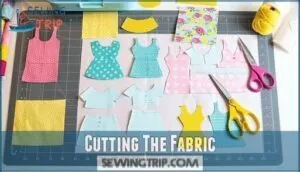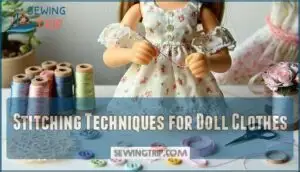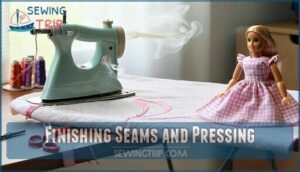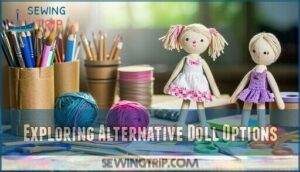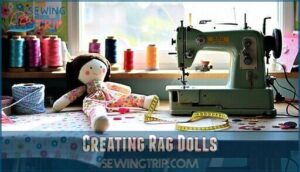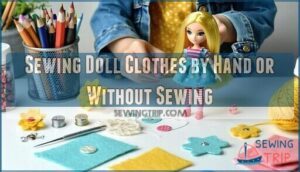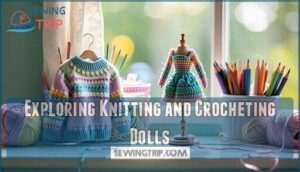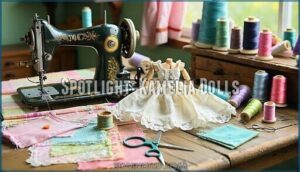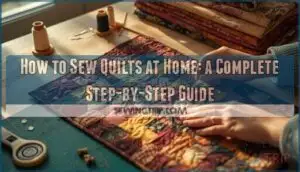This site is supported by our readers. We may earn a commission, at no cost to you, if you purchase through links.
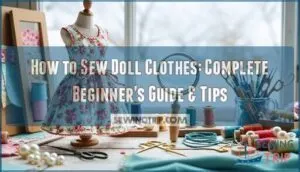 Learning how to sew doll clothes transforms your fabric scraps into tiny masterpieces.
Learning how to sew doll clothes transforms your fabric scraps into tiny masterpieces.
Start by selecting a simple pattern and lightweight fabrics like cotton or felt.
You’ll need basic supplies: scissors, pins, thread, and a sewing machine or needle for hand-stitching.
Trace your pattern onto fabric, cut carefully, and use small seam allowances (1/8 to 1/4 inch).
French seams work well for miniature garments since they’re self-finishing.
Press seams with a mini iron or wooden pressing tool.
Add closures like snaps or Velcro for easy dressing.
The secret lies in precision and patience—every stitch counts when working at this scale.
Table Of Contents
Key Takeaways
- Start simple and build your skills – Begin with basic patterns and lightweight fabrics like cotton or felt, then progress to more complex designs as you master fundamental techniques.
- Precision is everything at miniature scale – Use small seam allowances (1/8 to 1/4 inch), sharp scissors, and take accurate measurements, since every stitch counts on tiny garments.
- Choose the right tools and materials – You’ll need fine needles, quality thread, lightweight fabrics with small-scale prints, and closures like snaps or Velcro that work well on doll-sized clothing.
- Master key construction techniques – Learn French seams for clean finishes, press seams carefully with mini tools, and sew components flat before joining them to avoid wrestling with tiny tubes later.
General Tips for Sewing Doll Clothes
Sewing doll clothes requires patience and attention to detail, but the process becomes easier once you master a few key techniques.
You’ll need the right patterns, supplies, fabrics, and fitting adjustments to create professional-looking miniature garments that your doll can wear with pride.
Choosing The Right Doll Clothes Pattern
Pattern selection is your foundation for successful doll clothes sewing. Start with 18-inch doll clothing patterns since they’re beginner-friendly and widely available.
Check pattern reviews before purchasing digital patterns to avoid sizing issues. Simple designs with minimal pattern alterations work best initially.
Free online doll clothes patterns let you practice drafting basics without investment risks. You can also find patterns for fashion and plush dolls to expand your sewing options and make successful doll clothes with a good foundation.
Gathering Necessary Sewing Supplies
Your sewing kit makes all the difference between frustration and success.
Smart sewers stock up on essential tools before cutting their first pattern piece.
Essential Tools for doll clothes:
- Sewing machine with adjustable stitch length and zigzag capability
- Sharp fabric scissors plus pinking shears for finishing seams
- Fine sewing needles (size 70/10 universal) and quality thread types
- Measuring tools like small rulers and seam gauges for precise seam allowance
Add straight pins, seam rippers, and fabric markers to handle those tricky curves and tiny fasteners that doll clothes demand.
Using the right cutting implements guarantees clean edges.
Selecting The Appropriate Fabric
Choosing the right fabric can make or break your doll clothes project.
Quilting cotton tops the list for beginners – it’s forgiving, widely available, and comes in countless prints.
For Fabric Weight, stick with lightweight to medium weight fabrics that won’t overwhelm tiny seams.
Print Scale matters enormously; small patterns under 1/4 inch look proportional on dolls.
Understanding Knit vs Woven helps you match fabric type to garment style.
Woven fabrics work best for structured pieces, while knit fabrics suit stretchy items.
Prewashing Fabrics prevents post-sewing surprises.
For doll bodies, consider using woven fabrics like cotton or linen.
Adjusting Patterns to Fit Your Doll
Getting the right fit on your handmade creations starts with accurate doll measurements. Your fabric choice matters, but proper pattern scaling makes the difference between success and frustration.
Perfect measurements and proper pattern scaling turn fabric into flawless miniature masterpieces.
Take precise measurements of your doll’s chest, waist, hips, and limb lengths using a flexible tape measure. Compare these to the pattern’s finished measurements and make proportional adjustments.
Here’s your fitting roadmap:
- Draft block patterns by wrapping your doll in cling film and tape
- Test prototypes in muslin before cutting your good fabric
- Scale patterns mathematically using your doll’s proportions
- Make custom adjustments for unique body shapes or poses
Most doll clothes patterns need resizing patterns to match your specific doll’s proportions. Don’t skip prototype testing – it saves expensive fabric and prevents heartbreak later.
Keep detailed notes of your adjustments for future projects.
Tracing Doll Clothes Patterns
Accurate tracing forms the foundation of professional-looking doll garments.
Transfer your sewing patterns to fabric using these essential steps for perfect Pattern Accuracy:
- Select proper Transfer Methods – Use tracing paper or Swedish tracing paper for clean pattern transfers without damaging original templates
- Apply effective Marking Tools – Choose water-soluble fabric markers or tracing wheels that create visible marks on fabric’s wrong side
- Master Scaling Techniques – Align each pattern piece precisely on fabric’s grainline to guarantee proper drape and fit
- Include vital details – Mark all notches, darts, and construction symbols during the tracing process
- Verify Pattern Adjustments – Double-check transferred markings match original doll clothes patterns before fabric cutting begins
Proper tracing patterns technique eliminates guesswork and creates consistent results every time.
Step-by-Step Guide to Making Doll Clothes
Now you’re ready to transform your carefully chosen fabric into adorable doll clothes that’ll make your little one’s favorite companion look absolutely stunning.
This step-by-step process will guide you through each stage of construction, from cutting your fabric pieces to adding those special finishing touches that make handmade garments truly shine, with a focus on making handmade garments truly stunning.
Cutting The Fabric
After selecting your pattern and gathering supplies, proper fabric cutting sets the foundation for professional results.
Pin your pattern pieces to the fabric following the fabric grain direction indicated on each piece.
Use sharp cutting tools like fabric scissors or a rotary cutter with cutting mat for clean edges.
Maintain consistent seam allowance measurements throughout.
Efficient cutting means organizing pattern layout before making cuts, and consider using freezer paper templates for repeated patterns.
Stitching Techniques for Doll Clothes
With your fabric pieces cut and ready, it’s time to master the sewing techniques that’ll make your doll clothes shine.
Hand sewing offers incredible precision for tiny seams, while machine stitching speeds up construction. Use short stitch lengths—no more than 2.5mm—to maintain proportion and prevent puckering on miniature garments.
Here are three fundamental techniques every doll clothes maker should master:
- Backstitching creates strong, durable seams perfect for high-stress areas like armholes and waistbands
- Running stitch works beautifully for basic seams and gathering sleeves or skirts
- Whipstitch secures edges and attaches small components like snaps invisibly
When curve sewing, take your time and use a stiletto to guide fabric smoothly. For seam finishes, consider French seams or zigzag stitches to prevent fraying.
Many resources offer materials for backstitching doll clothes. Remember to "sew in the flat"—hem sleeves and pant legs before attaching them to avoid wrestling with tiny tubes later.
Finishing Seams and Pressing
After stitching your doll clothes, pressing seams properly transforms your work from homemade to professional-looking.
Press seam allowances to one side using an up-and-down motion—never drag the iron across delicate fabric.
| Technique | Purpose | Tool |
|---|---|---|
| Seam Bulk Reduction | Minimize thickness | Sharp scissors |
| Curve Clipping | Smooth curved seams | Small snips |
| Corner Trimming | Sharp points | Diagonal cuts |
| Topstitching Tips | Secure pressed seams | Matching thread |
Trim seam allowances to ⅛-inch on curves and clip notches every ½-inch.
For corners, cut diagonally close to stitching.
Use pressing hams for curved areas and always protect fabric with a pressing cloth.
Neatening raw edges with pinking shears prevents fraying.
Adding Embellishments to Doll Clothes
Magic happens when you transform plain doll clothes into stunning pieces with the right embellishments.
Start with buttons and beads to create focal points on bodices or cuffs. Lace application along hems and necklines adds instant elegance. Ribbon details work perfectly as belts or trim accents.
Try painting fabric with fabric paint for custom designs. Master basic embroidery stitches like French knots and running stitches for delicate touches.
Appliques offer quick decorative solutions. Remember that trims should match your doll’s scale – choose narrow lace and small buttons to maintain realistic proportions.
Tips for Making Doll Clothes for 18-Inch Dolls
Working with 18-inch dolls opens up a world of sewing possibilities since their larger size makes them easier to handle than smaller dolls.
You’ll find that the increased fabric area gives you more room to add details like pockets, decorative stitching, and realistic closures that would be difficult on tiny dolls.
Exploring Alternative Doll Options
While mastering doll clothes sewing opens creative doors, DIY Dollmaking with Repurposed Materials offers exciting alternatives.
You’ll discover countless ways to craft Unique Doll Bodies using everyday items. Custom Doll Faces and Eco-Friendly Dolls expand your creative toolkit beyond traditional sewing doll clothes patterns.
A good starting point involves understanding basic stitches for doll clothes.
Consider these alternative approaches:
- Transform cardboard tubes and popsicle sticks into quick craft dolls
- Upcycle old stuffed animals into practice dolls for doll clothing experiments
- Create paper dolls with DIY doll clothes for sustainable crafting
- Use fabric scraps and yarn for no-sew textile dolls
- Repurpose dollar store toys as custom doll bases for sewing practice
Creating Rag Dolls
Creating your own handmade dolls opens up endless possibilities for sewing doll clothes with custom-fit doll clothing patterns.
Start by selecting soft fabrics like flannel or cotton for the body, then choose your Stuffing Materials—polyester fiberfill works best for even distribution.
Consider these essential elements for your DIY doll clothes project:
- Ragdoll Anatomy: Plan proportions before cutting—head should be about 1/4 of total height
- Fabric Choices: Use coordinating prints for body and limbs, avoiding heavy materials that add bulk
- Jointing Methods: Simple sewn joints work better than complex mechanisms for beginners
- Facial Features: Embroider or use fabric paint rather than small buttons for safety
- Stuffing Materials: Pack firmly but leave some give for natural movement and positioning
Once you’ve constructed the basic doll structure, you’ll have a perfect canvas for experimenting with various doll clothes patterns and techniques.
Sewing Doll Clothes by Hand or Without Sewing
Hand sewing offers incredible freedom when making doll clothes without traditional machine work.
You’ll discover that fabric glue creates strong bonds for no-sew methods, while simple fastening techniques like snaps work perfectly.
Try upcycling materials from old clothing scraps for authentic handmade doll clothes.
| Method | Materials | Best For |
|---|---|---|
| Hand Stitching | Needle, thread, fabric | Precise seams, durable garments |
| Fabric Glue | Washable fabric adhesive | Quick hems, appliques, felt pieces |
| No-Sew Clips | Snaps, velcro, safety pins | Temporary closures, easy changes |
These nosew doll clothes techniques let you create beautiful garments using basic doll clothes patterns without complex equipment, allowing for precise seams and durable garments with simple fastening techniques.
Exploring Knitting and Crocheting Dolls
While sewing remains the primary method for creating doll clothes, knitting and crocheting offer exciting alternatives that can produce stretchy, cozy garments perfect for your doll’s wardrobe.
These techniques work especially well for sweaters, hats, and blankets, giving you more creative options beyond traditional fabric construction.
Knitting Doll Clothes
When you’re ready to tackle knitting doll clothes, start with yarn selection – fingering or sport-weight yarns work best for tiny garments.
These lightweight options create realistic proportions without bulk.
Choose shorter needles (10-15cm) for comfort when working small pieces.
Master basic knit stitches like stockinette and garter before advancing to cables or lace.
Your gauge swatch isn’t optional – it’s essential for proper fit since dolls can’t grow into oversized clothes.
Use needle sizes smaller than typical to achieve tight, even stitches.
Pattern design requires careful planning.
Work seamlessly from the top down when possible to avoid bulky seams.
Place stitch markers strategically when dividing for sleeves or shaping.
Considering the benefits of needlework, knitting doll clothes can be a relaxing and rewarding hobby.
For finishing touches, block pieces gently to measurements.
When sewing with knit fabric or working with stretch materials like jersey and interlock knit, use mattress stitch for invisible seams.
Small embellishments like tiny buttons or ribbon trim add professional polish to your miniature masterpieces.
Crocheting Doll Clothes
Crocheting doll clothes opens up endless creative possibilities for your handmade dolls.
Start with cotton or acrylic yarn in sport weight for best results.
Master basic crochet stitches like single and double crochet to build foundational doll outfits.
Design simple patterns using continuous rounds for seamless sleeves and pants.
Add embellishment ideas like tiny buttons or surface crocheting for detail.
Practice sizing techniques by adjusting rounds and chains for custom fits across different doll accessories and clothing pieces.
Spotlight: Kamelia Dolls
If you want to see how seasoned doll makers tackle miniature sewing challenges, Joanna from Kamelia Dolls offers valuable insights from her extensive experience creating clothes for handcrafted dolls.
Her approach combines traditional techniques with practical shortcuts that make working with tiny patterns and delicate fabrics much more manageable, using traditional techniques to achieve the desired outcome.
Doll Collection and Inspiration
Discovering your perfect doll collection starts with understanding what speaks to your creative heart.
Each doll tells a story through custom dolls and unique doll clothing inspiration that reflects both doll history and personal vision.
Here are five ways to build your inspiring collection:
- Research doll sizes to guarantee consistent clothing compatibility across your collection
- Connect with the collector community through forums and social media for doll outfit ideas
- Study doll fashion from different eras to understand evolving styles and techniques
- Develop display ideas that showcase your dolls’ personalities and custom clothing
- Document your journey with photos of each doll clothing creation and inspiration source
Your collection becomes a canvas for experimenting with doll clothing ideas that range from historical reproductions to modern interpretations, creating a personal museum of miniature fashion artistry.
Miniature Sewing Tips From Joanna
Since miniature sewing demands precision, Joanna from Kamelia Dolls shares her expert techniques for creating stunning tiny stitches.
Her approach combines careful fabric stabilizing with specialized hand sewing methods that elevate your doll clothes tutorial results.
- Use 3mm seam allowances for Barbie-size dolls to maintain accurate proportions
- Apply fabric stabilizing with starch before cutting to prevent seam distortion
- Master tiny stitches through slow, deliberate machine work at low speeds
- Choose embellishment tricks like hand-applied beading over bulky machine decorations
- Perfect seam finishes by lining garments rather than hemming for cleaner edges, which helps achieve cleaner edges and requires specialized hand sewing.
Useful Links for Kamelia Dolls
Finding reliable Kamelia Resources can transform your doll clothes tutorial experience.
Start with Pattern Websites offering doll clothing patterns free downloads, then explore Fabric Suppliers for quality materials.
Tutorial Channels provide step-by-step guidance for sewing doll clothes, while Community Forums connect you with fellow makers.
These doll dress patterns and sewing tutorials create your complete toolkit for miniature garment success.
Spotlight: Mieke Timeless Dolls
You’ll discover expert techniques from Mieke, a skilled dollmaker who specializes in creating timeless, handcrafted dolls with attention to every detail.
Her approach combines traditional craftsmanship with practical methods that make doll clothes construction both efficient and enjoyable.
Doll Hair and Makeup Tips
Transform your doll’s appearance with expert hair and makeup techniques.
Master Hair Fiber Types like mohair and saran for realistic textures. Practice Rooting Techniques to secure strands firmly into the scalp.
Experiment with Wig Styling using tiny scissors and styling tools for perfect cuts. Apply Faceup Sealants to protect painted features.
Focus on Customizing Features like eyebrows and lips with fine brushes. These skills complement your handmade doll clothes perfectly.
Workflow for Making Doll Clothes
With Pattern Preparation complete, your sewing doll clothes journey begins with systematic Fabric Cutting using sharp scissors and accurate measurements.
Focus on precise Seam Construction by stitching in the flat—completing hems and details before joining side seams. This approach prevents wrestling with tiny tubes later.
Plan your Embellishment Timing carefully, attaching ribbons and trim before final assembly for easier handling.
Remember that pre-washing fabric can prevent shrinkage.
Press seams as you work, clip curves, and save Finishing Touches like buttons for last when using doll clothing patterns.
Mieke’s Personal Favorites and Recommendations
Mieke’s expertise shines through her favorite fabrics and recommended tools for crafting stunning doll garments.
She prefers silk-like synthetics and cotton blends that drape beautifully on miniature forms. Her pattern preferences lean toward historically-inspired doll dress patterns, especially Renaissance and Victorian styles.
When sewing doll clothes, Mieke recommends fine needles and quality scissors for precision work. Her sewing techniques emphasize hand-finishing for authentic period details.
For embellishment choices, she favors tiny pearls, metallic threads, and delicate lace trim. These doll clothing patterns require patience, but the results transform ordinary dolls into museum-worthy pieces.
Frequently Asked Questions (FAQs)
Can you sew doll clothes by hand?
Yes, you can absolutely sew doll clothes by hand.
Hand sewing offers more precision for small details and tight spaces.
Use small stitches, trim seam allowances to ⅛-inch, and press seams as you work for professional results.
What is the best fabric to sew doll clothes?
Funny how often the smallest scraps work best—choose lightweight, tightly woven cotton or lawn for doll clothes.
These fabrics hold their shape, aren’t bulky, and drape well.
Avoid thick or slippery materials to keep sewing easy.
How do you wash finished doll clothes?
Hand wash finished doll clothes gently in cool water with mild detergent.
Avoid harsh scrubbing that could damage tiny seams.
Rinse thoroughly, press out excess water with a towel, and air dry flat to prevent stretching or shrinkage, using mild detergent and avoiding harsh scrubbing.
What closures work best for doll clothing?
Hook and loop tape, snaps, and small buttons work best for doll clothing closures.
They’re easy to manipulate on tiny garments and create secure fastenings that won’t damage delicate fabrics or frustrate little hands during dress-up play, making them ideal for delicate fabrics.
How to store doll clothes long-term safely?
Like treasured heirlooms passed down through generations, your doll’s wardrobe deserves careful preservation.
Store clothes flat in acid-free tissue paper inside breathable cotton bags or archival boxes.
Keep them away from direct sunlight and moisture to prevent fading and mildew damage, and ensure they are stored in a way that preserves their quality, with careful handling and storage.
Can you alter existing doll clothes patterns?
Yes, you can easily alter existing doll clothes patterns to customize fit, style, and details.
Adjust measurements, change necklines, modify sleeve lengths, or add decorative elements to create unique designs for your doll’s wardrobe.
Whats the best way to organize patterns?
Only 25% of sewers keep organized pattern collections.
Store your physical patterns in labeled manila envelopes or plastic sleeves inside a binder.
Create digital backups by scanning or photographing each piece, then organize files by doll size and garment type for quick access.
Conclusion
Sarah spent hours trying to squeeze a store-bought dress onto her daughter’s American Girl doll, only to rip the seams.
She decided to learn how to sew doll clothes instead. Mastering doll clothing construction opens endless creative possibilities for your collection.
You’ve learned essential techniques from pattern selection to finishing touches. Remember that precision matters most at this miniature scale.
Start with simple designs, practice your stitching, and gradually tackle more complex garments. Your dolls deserve handmade wardrobes that fit perfectly and last for years of play, providing a sense of lasting quality.
- http://www.phoebeandegg.com/blog/2014/7/23/buying-fabric-for-doll-clothes-online-my-resources
- https://www.pincutsewstudio.com/blog/2016/7/25/tips-for-sewing-doll-clothes
- https://mellysews.com/how-to-make-doll-clothes/
- https://www.reddit.com/r/Dolls/comments/1c570ou/make_your_own_doll_clothes_patterns/
- https://www.youtube.com/watch?v=OQdluLOwzqA

